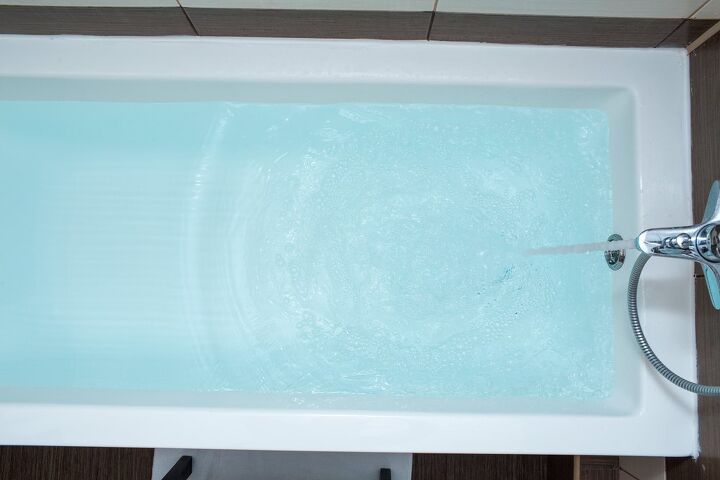Why Is My Bath Water Blue? (Find Out Now!)

Baths are a great way to unwind and relax after a long, stressful day. However, there’s one thing that can spoil the mood: funky colored water. Why is your bath water blue?
Your bath water is blue due to 1.3 Mg/L or greater of copper deposits in your water supply. This can be caused by things like high water pressure, increased or decreased water pH, and pipe corrosion. Avoid bathing in or drinking blue water, as it can cause severe health complications and result in vomiting and diarrhea.
Blue water can also be caused by laundry detergents and other cleaning products that contain blue dye. If this is the case, the discoloring should resolve itself and disappear after a few hours or days.
In this article, we’ll get to the bottom of why your bath water is blue, whether or not you should be worried about safety, and how you can fix the problem!
Do You Need to Hire a Plumber?
Get free, zero-commitment quotes from pro contractors near you.

Why Is My Bath Water the Color Blue?
Blue bath water is definitely less alarming than brown bath water, but why is this happening? There’s a reason.
Your bath water is likely the color blue because it contains elevated amounts of copper. Excessively high or low pH of the water can also cause an increased amount of copper and result in your water exhibiting a blue-green or aquamarine hue.
Now- why does your water contain excessive amounts of copper? The most reasonable explanation is that your water pipes are corroding. If you’re living in an older home, especially if the water is hard and heavily treated (like in Florida), you’re more susceptible to this issue.
Other reasons include:
- Unusually high water pressure
- Sediment traveling through your pipes
- The presence of active microorganisms
If your home has steep pipes and water is able to collect in a corner of your system, this will result in corrosion. That’s why it’s important that your home is built to code, and having a home inspector investigate this is crucial.
Last but not least, it’s possible that your blue bath water is completely harmless. If you recently put in cooler-toned lighting or changed the wall color to a blue tone, the water could just be reflecting the room.
Get a qualified plumber’s opinion to be sure!
Is It Safe If My Bath Water Is Blue?
Now that we know why your bath water is blue, is it safe to use it? Here’s what we think.
Not at all– excessive amounts of copper (whether you’re ingesting it, inhaling it, or coming into contact with it) can cause serious sickness. Many people have experienced nausea, diarrhea, vomiting, and other side effects of poisoning.
Once you notice a blue tint to your water, call your plumber right away to get to the root of the problem. Avoid showering, washing your hands, or drinking tap water, and keep your kids away from the faucet.
Because water pipes are interconnected, although you only see blue bath water, the copper is likely seeping into your sink supply and other areas of the house.
How Can I Fix Blue Bath Water?
If you’re experiencing this issue, the best plan of action is to call in an experienced plumber. Although there are at-home copper water testing kits available for purchase, it’s best to call in a professional to ensure a comprehensive fix.
In general, copper is considered hazardous when it exceeds 1.3 milligrams per liter (mg/L) in water. Your plumber will be able to measure this and map out a solution.
If the problem is due to high water pH, adding acidic substances like vinegar or muriatic acid can resolve the issue. These chemicals are able to bind with copper, so it no longer exists in your water supply.
Other options for fixing the problem include:
- Using anti-scaling cleaning products
- Installing a reverse osmosis water filter or phosphate feeder
- Adding calcite chips to the bottom of an existing water well
- Replacing the corroded pipes
Your plumber will determine the best solution for you based on your unique situation.
Why Is My Blue Bath Water Not Going Away?
So, you’ve had a professional come out to treat your blue bath water, but it’s still not going away. Why is this problem persisting?
If you can’t rid your bath water of its blue tint, it’s probably because your pipes are corroded beyond repair. There could be an external leak or such an extensive amount of copper deposit that no filter or reversal treatment is able to help.
If that’s the case, it’s time for an entirely new plumbing system. Unfortunately, repiping an entire home can cost an average of $4,000 and even exceed $20,000. The final cost will depend on where you live and the scope of the project.
Although this isn’t what you want to hear, it’s more cost-effective for your house and better for your health to do a more permanent fix. Otherwise, you could suffer severe physical and monetary consequences down the line.
Related Questions
Why is my bath water brown?
Brown bath water is an unsightly scene and not for the squeamish. Why does it look like you’re showing in pure sewage?Frankly, it could be because you are. Other causes include sediment from oxidized metals like iron or rust. When this water is left stagnant, it can become a breeding ground for bacteria.Although most sources say bathing in rusty water isn’t the end of the world, we advise against doing so- especially if you’re unsure of the cause. You never want to drink discolored water either.If your bath water is brown, call a plumber immediately. You might have a block in your sewage system! Additionally, check to see if there is or was a water outage in your area. Sometimes the water supply source is to blame.
Why is my bath water lukewarm?
Consistently lukewarm bath water is usually associated with a water heater problem.A maintenance professional or plumber should be able to safely turn up the maximum water temperature limit. Otherwise, your system could be having issues with its upper heating element.This can be caused by things like sediment or a damaged dip tube.
How hot can my bath water be when I’m pregnant?
When you’re pregnant, certain societal norms can become dangerous for your unborn baby. An excessively hot bath is one of them.The average body temperature of a pregnant woman is slightly higher than average, at around 98-99 degrees Fahrenheit. It’s best to keep your bath water no hotter than 100 °F in order to limit pregnancy complications.For this reason, it’s also advised to avoid steam rooms, saunas, and extremely hot temperatures while pregnant, as such conditions can cause neural tube defects.
Do You Need to Hire a Plumber?
Get free, zero-commitment quotes from pro contractors near you.

Final Thoughts
If your bath water is blue, it’s important to know why. There are many reasons for the change in color- some of them harmless, and others require immediate attention.
The most common reason for blue bath water is excessive copper deposits as a result of water pipe corrosion. However, it’s good to be aware of all of the other possible explanations listed above, so you can take action if necessary.
Always consult an experienced plumber if your problem persists!

Emily is a copywriter with over five years of experience in crafting content for the home renovation and remodeling industry. She loves house projects, whether it be painting a room or tweaking small design elements to transform a space. Her favorite aesthetic is french modern because of its clean lines and airy feeling! When not writing, Emily loves to travel and check out architectural details all over the world.
More by Emily Carr



























